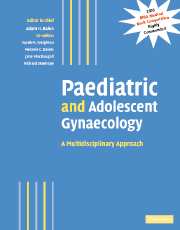Book contents
- Frontmatter
- Contents
- Contributors
- Preface
- Part I Normal development
- 1 Embryology of the female genital tract
- 2 Molecular genetics of gonad development
- 3 Gonadotrophin receptors
- 4 Normal childhood, puberty and adolescence
- 5 Control of the menstrual cycle and fertility
- 6 Nutrition and reproductive function
- 7 Normal bladder control and function
- 8 Development of sexuality: psychological perspectives
- Part II Management of developmental abnormalities of the genital tract
- Part III Management of specific disorders
- Index
- Plate section
- References
5 - Control of the menstrual cycle and fertility
from Part I - Normal development
Published online by Cambridge University Press: 04 May 2010
- Frontmatter
- Contents
- Contributors
- Preface
- Part I Normal development
- 1 Embryology of the female genital tract
- 2 Molecular genetics of gonad development
- 3 Gonadotrophin receptors
- 4 Normal childhood, puberty and adolescence
- 5 Control of the menstrual cycle and fertility
- 6 Nutrition and reproductive function
- 7 Normal bladder control and function
- 8 Development of sexuality: psychological perspectives
- Part II Management of developmental abnormalities of the genital tract
- Part III Management of specific disorders
- Index
- Plate section
- References
Summary
Introduction
During her reproductive ‘lifespan’ of approximately 35 years, a woman who neither conceives nor uses hormonal contraception will experience over 400 menstrual bleeds. It is a remarkable feature of human ovulation that the sequence of events is so finely coordinated to ensure that there is maximum chance of achieving a pregnancy by synchronizing the release of a mature oocyte with the time of maximum receptivity of the endometrium and, in addition, if a pregnancy is not established that cycle, the entire sequence of events is repeated the next month (Fig. 5.1). Even more extraordinary perhaps, given the enormous hormonal and biochemical changes wrought by pregnancy, is the fact that, in the absence of lactation and breastfeeding, the whole sequence can start up again shortly after delivery.
From an evolutionary standpoint, it is clear that this is a wasteful and potentially hazardous situation. One must remember, however, that during the long eons of evolutionary time, women would not have entered puberty until they were much older than is the current case and pregnancies not only would have been “unavoidable” but would have been followed by a prolonged period of breastfeeding during which time ovulation, and hence menstruation, would have been suppressed. Our ancestors would probably have experienced only a fraction of the number of menstrual cycles that modern women have to endure.
- Type
- Chapter
- Information
- Paediatric and Adolescent GynaecologyA Multidisciplinary Approach, pp. 51 - 58Publisher: Cambridge University PressPrint publication year: 2004



